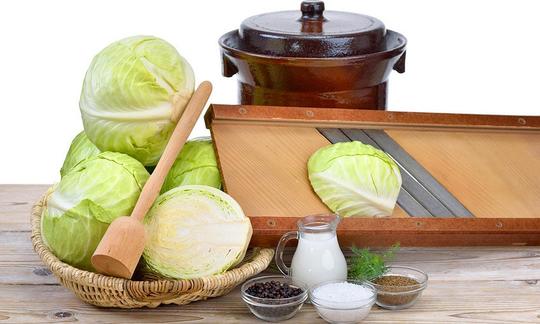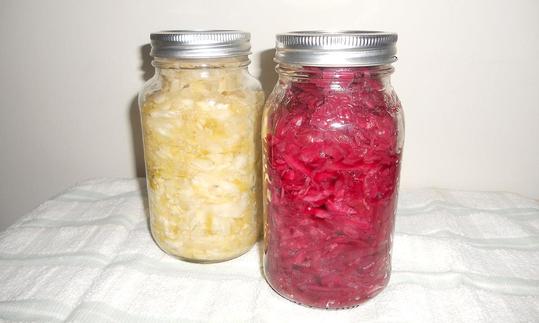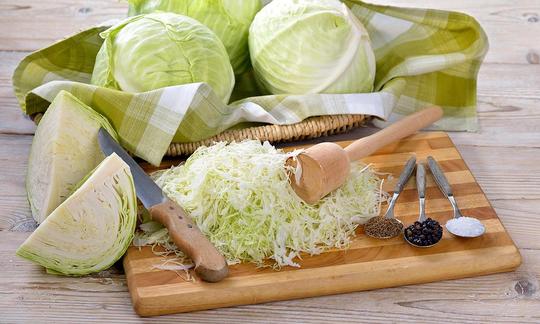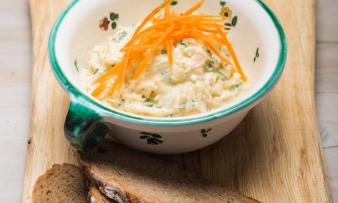Sauerkraut is produced by fermenting white cabbage ( Brassica oleracea convar. capitata v ar. alba ) or pointed cabbage with the help of lactic acid bacteria. Preserved , pasteurized sauerkraut ( or pasteurized sauerkraut ) differs from raw sauerkraut in that it is subsequently heated to 60-100 °C.
Use in the kitchen:
Today, sauerkraut is considered a typical German dish worldwide. It is usually used as a side dish or as a sandwich filling.
How long do you have to cook sauerkraut? You don't have to cook it at all because it can also be eaten raw. When preparing sauerkraut, it is often stewed with a little water or with broth and fat - for about half an hour. Spices contained in the product or added during cooking are salt andpepper , but also bay leaves , juniper berries , caraway seeds , cloves or dried marjoram . Tarragon , fennel seeds , savory or sugar can also be used. Depending on the region, the sauerkraut is refined with onions , apples or grapes . In Hesse, for example, apple juice is used and in Thuringia beer.
Sauerkraut is also eaten as a strudel, which is covered in dough and baked in the oven. Other variations - with spaetzle or as a sauerkraut casserole with potatoes baked in the oven - are also very popular.
Vegan recipe for potato-sauerkraut rösti:
450 g potatoes , 250 g sauerkraut, 1 tbsp cornstarch , 1/2 tsp salt, pepper, nutmeg , parsley , oil for frying (e.g. rapeseed oil orsunflower oil ).
Boil washed, peeled potatoes in salted water. Then let them cool a little and mash them with a potato press. Season with salt, pepper, ground nutmeg and some of the chopped parsley. Drain the sauerkraut, add it to the potatoes after squeezing it a little and mix well. Put a little oil in a non-stick pan, form small patties and fry in the oil on both sides until golden brown. Serve sprinkled with the remaining parsley.
| Not only vegans or vegetarians should read this: Vegans often eat unhealthily. Avoidable nutritional mistakes . |
Shopping - where to buy?
Pasteurized sauerkraut is available all year round at all supermarket chains such as Coop , Migros , Denner , Volg , Spar , Aldi , Lidl , Rewe , Edeka , Hofer etc. Most supermarkets and of course organic supermarkets ( Denn's Biomarkt ) also offer organically produced sauerkraut in 250 g or 500 g bags, jars or small buckets. Sauerkraut can sometimes be found loose at butchers, retailers, health food stores and markets. Organic sauerkraut does not contain sugar or sugar substitutes, nor preservatives such as sorbic acid (E 200), formic acid (E 236) or benzoic acid (E 210). 1
Sauerkraut is also available in raw food quality; read the description on the packaging carefully or ask the seller/producer whether it is really raw, natural and unheated (unpasteurized).
Sauerkraut juice is a vegetable juice made from pressed, raw sauerkraut. Sauerkraut juice contains a lot of vitamin C, lactic acid and live lactic acid bacteria and is considered to stimulate digestion. It is available in organic supermarkets, organic shops or online.
Storage:
If you open a package of sauerkraut and reseal it airtight, the cabbage will keep in the fridge for a few days - regardless of whether it is pasteurized or not. Yeast from the air and the oxygen that makes the yeast grow can cause the product to spoil more quickly. Sealed airtight in bags or in jars/buckets, sauerkraut, pasteurized or unpasteurized, will keep for a very long time.
Making your own raw sauerkraut:
If you want to make your own raw sauerkraut, you can do it easily and on a small scale at home. To do this, you chop white or pointed cabbage very finely or shred it on a special cabbage slicer. While the cabbage was traditionally fermented in earthenware vessels or wooden barrels, screw-top jars are preferred today. The cabbage is layered with salt (1.5%), pressed together and the vessel sealed airtight. Now the lactic acid bacteria that naturally live on the cabbage can process the sugar contained in the cabbage into lactic acid under optimal conditions (heat, absence of oxygen, salt, liquid). The fermentation process lowers the pH value, which extends the shelf life of the sauerkraut. The cellulose of the hard leaves decomposes and the sauerkraut is much more digestible than fresh, raw cabbage. 2
Ingredients - nutritional value - calories:
Preserved sauerkraut has very little energy at 19 kcal/100g. The carbohydrate content is around 4%, and the fat and protein content is very low.
Due to the preservation method, which involves adding table salt, the salt content is very high at 1,679 mg/100g. This also applies to sodium (661 mg/100g). It is therefore recommended to rinse sauerkraut with water before eating it.
The vitamin C content of 15 mg/100g of sauerkraut does not seem very high, but this can be increased somewhat by gently heating it. If you eat larger quantities, the fermented cabbage does contribute well to your daily vitamin C requirement. If you combine sauerkraut with, for example, yellow bell peppers (183 mg/100g) and fresh herbs such as thyme (160 mg/100g), wild garlic (150 mg/100g) or parsley (133 mg/100g) 3 in a meal, then you will definitely have covered your daily requirement of around 100 mg 4. This water-soluble vitamin is an important antioxidant. Regular intake of sufficient vitamin C prevents vitamin deficiency diseases and strengthens the immune system.
The vitamin K contained in sauerkraut is around 13 µg/100g. This value can vary slightly depending on the product. The German Heart Foundation has given an average value of 7.7 µg/100g sauerkraut after tests. This information is particularly important for people at risk of thrombosis, as they often take anticoagulants. 5 Fermented foods contain vitamin K 2 (menaquinone) produced by bacteria, while other green plants tend to contain phylloquinone (vitamin K 1 ). Green vegetables and salad in particular have high levels, such as chard (830 µg/100g), kale (705 µg/100g) and spinach (483 µg/100g). 3 This fat-soluble vitamin is very important for blood clotting and bone metabolism.
The folic acid (or folate as a folic acid-active substance group) content in sauerkraut is also worth mentioning at 24 µg/100g. Blackberries and Hokkaido pumpkins have similar values. 3 The daily folic acid requirement of around 300 µg 4 for an adult can be easily covered with a combination of pulses (e.g. cooked chickpeas : 63 µg/100g, cooked lentils : 181 µg/100g or cooked white beans : 102 µg/100g) and green leafy vegetables (e.g. spinach : 194 µg/100g, lamb's lettuce : 145 µg/100g). 3 Folic acid fulfils important functions in many areas of our body, such as cell growth, protein metabolism and the development of the unborn child.
Sauerkraut also contains iron , potassium , vitamin B6 (pyridoxine) , manganese and calcium . You can see all the essential ingredients and nutrients in the tables after the text.
Which bacteria are in sauerkraut? Depending on the fermentation phase, sauerkraut contains acetic acid bacteria, heterofermentative lactic acid bacteria (e.g. Leuconostoc species) and homofermentative lactic acid bacteria (e.g. Lactobacillus species).
Health aspects - effects:
How healthy is sauerkraut from a jar? Pasteurized sauerkraut most likely no longer has the same beneficial effects as the raw product. Heating it to at least 60 °C kills the living lactic acid bacteria, and it only contains lactic acid. This makes it taste much milder and hardly sour, which appeals to many consumers, but also reduces the health benefits.
Is raw sauerkraut good for the intestines? Even with raw sauerkraut (without pasteurization), it is not entirely certain whether the living lactic acid bacteria really have a positive effect on the intestinal flora. This is because most bacteria die in the acidic stomach environment and it is not known "which bacterial strain is beneficial to health under which conditions and for which people". 6
However, there are studies (e.g. from the University of Giessen ) which say that sauerkraut and the Korean version with Chinese cabbage (kimchi) - when eaten regularly (200-300 g daily) - have a preventive effect against colon cancer. 7 Perhaps this is because the fiber content in sauerkraut contributes significantly to an increase in intestinal bacteria and thus has a positive effect on stool volume. 8 Finnish studies also come to the conclusion that the isothiocyanates in sauerkraut slow the growth of cancer in the lungs, breast, liver and intestines in animal experiments.
Is sauerkraut healthy? Ascorbic acid is also bound in sauerkraut and white cabbage in the form of ascorbigen A and B (C-2-scatyl-L-ascorbic acid). If you cook the vegetables, the molecules break down into L-ascorbic acid and 3-hydroxyindole. This means that gently cooked sauerkraut contains more vitamin C than the raw version. However, cooking for too long destroys the vitamin. 9 This knowledge was also put to use in the 18th century and sailors were given sauerkraut as a year-round supply. The vitamin C content in sauerkraut reduced the occurrence of the vitamin deficiency disease scurvy. 10
Dangers - Intolerances - Side effects:
Fermented products such as sauerkraut have a high histamine content. People with histamine intolerance or intolerance should avoid sauerkraut because such high amounts of histamine can trigger symptoms such as severe digestive problems, skin redness, itching, dizziness, headaches, chronic runny nose, etc. 11
Sauerkraut contains traces of vitamin B 12 , but these amounts cannot cover our needs. In addition, we still do not know whether these substances referred to as vitamin B 12 are not analogues, but only suspect that they are. At least the proportion is minimal and very variable. This is the answer of a food engineer from ETH Zurich who works in a large sauerkraut company. Sauerkraut artificially enriched with vitamin B 12 must have a note on the packaging.
General information:
The ancient Chinese, Phoenicians and later the Greeks and Romans used sauerkraut; Hippocrates prescribed it as a tonic around 400 years before Christ. In Korea, vegetables preserved by lactic acid fermentation are called kimchi. It is eaten every day, especially in winter. Instead of white cabbage ( togil kimchi), traditional kimchi contains Chinese cabbage. Cucumbers, leeks and radishes are also used to make this "Korean sauerkraut" - plus Asian ingredients. Kimjang is the name given to the communal production of kimchi. Ginger and plenty of garlic or chili powder are also used to add flavor. There are numerous books about fermentation.
Alternative names:
During World War II, English-speaking soldiers derogatorily called Germans "krauts", which is why the name sauerkraut is still common in English today. During World War I, sauerkraut was called liberty cabbage in the USA, but today it is often translated as pickled cabbage.
Literature - Sources:













Comments